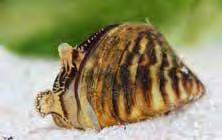
2 minute read
Water Warrior
It’s A Pecking Order (at the lakes)
by Dr. Nate Bosch, director of the Lilly Center for Lakes & Streams
There’s a pecking order in our lakes. It’s a ‘who-eats-who’ directory that results in organisms eating or aiding other organisms in sometimes unexpected ways. In ecology, we call this a food chain, or a food web.
Primary Producers: The Lowest Rung on the Pecking Order Algae and weeds, fed by nutrients, comprise the bottom of the food chain. Aquatic plants are essential for a balanced underwater ecosystem. The nutrients feeding them result from many sources, including soil erosion, lake-bottom muck, fertilizer spread on lawns and farms, and animal waste from pets or livestock. Nutrients are good… but only in limited amounts! In lakes throughout Kosciusko County, phosphorus and nitrogen cause most of the aquatic plant growth. These nutrients are washed into the water from our yards, streets and crops, and they often cause algae blooms and excessive weed growth.
Primary Consumers: Herbivores that Munch on Algae Zooplankton comprise the next level of the lake food chain; they eat the algae. Swimming zooplankton are barely visible to the naked eye. A couple of common types in our lakes are cyclops, daphnia, and a variety of freshwater mussels, including zebra mussels. Zebra mussels snag algae out of the lake like mini water filters, but unfortunately will not eat the blue-green algae. This algae can produce toxins that can be harmful for people and pets who enjoy our lakes.
Secondary Consumers: Small Fish that Make a Big Impact The upper layers of the food chain are primarily composed by fish. The smaller fish found in this level, planktivores that include bluegill and yellow perch, eat zooplankton. These small fish are stuck in the middle of the food chain, affecting and being affected by the levels above and below them. For example, if there are many small fish in a lake, they can substantially reduce the zooplankton populations which can allow the algal populations to increase.
Tertiary Consumers: The Dominating Trophy Fish The top of the food chain, the fifth level, is dominated by piscivores. Examples of piscivores include northern pike and largemouth bass… fish that eat other fish! They rely on the lower rungs of the food chain, but if the piscivore population is too high, the population of smaller fish will shrink. That allows for more zooplankton, which ultimately reduces algae populations.
Every food chain level is important for a balanced and healthy lake habitat. To learn more and stay informed, sign up for the Lilly Center’s e-newsletter or check out our Field Notes blog.
The Lilly Center for Lakes & Streams at Grace College conducts research, provides resources, engages and educates residents, and collaborates with local organizations to make the lakes and streams of Kosciusko County clean, healthy, safe and beautiful. To date, the Lilly Center has conducted scientific research on over 30 streams and 40 lakes. The Lilly Center is driven to create a legacy of stewardship by equipping community members, visitors and future generations to understand and enjoy the county’s natural beauty. For more information, visit lakes.grace.edu. Primary Producers Algae

Primary Consumers Zooplankton

Primary Consumers Zebra Mussels

Secondary Consumers Small Fish











